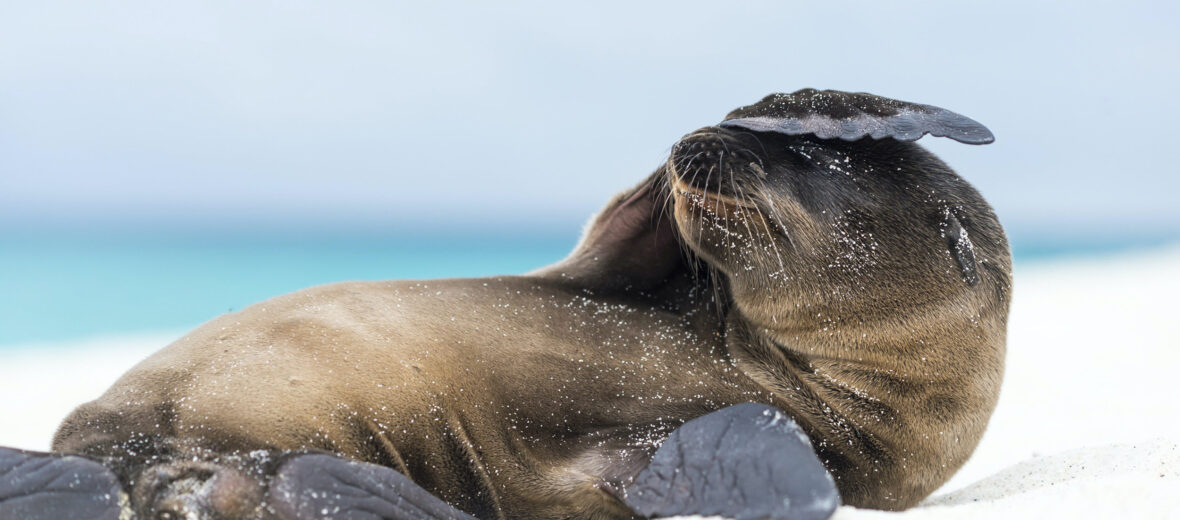
The Galápagos sea lion lives and breeds on the Galápagos Islands. They can also be found on Isla de la Plata, mainland Ecuador, and Isla del Coco. These sea lions have a preference for low-lying sandy beaches and steep, rocky cliff sides. Due to Invasive species, disease, climate change, and pollution these critters are listed as Endangered by the IUCN. There are only an estimated 10,600 individuals remaining in the wild and their populations are decreasing.
First the Stats…
Scientific name: Zalophus wollebaeki
Weight: Up to 550 lbs.
Length: Up to 8.3 feet
Lifespan: Up to 24 years
Now on to the Facts!
1.) To hide from the hot sun, they will hide under cliffs, vegetation, and rocks.
2.) Galápagos sea lions, being very social, will form large groups on their hauling-out areas.
3.) As they age, males will begin fighting to take control over a harem, which consists of around 5 – 25 cows. They also fight for territory.
4.) There are 2 types of males non-territorial and territorial.
5.) Territorial males vocalize more frequently to make their intentions for a mate known and to signal to non-territorial males that they shouldn’t be intruding into their territory.
But wait, there’s more on the Galápagos sea lion!
6.) The adult male or bull typically only holds onto a territory and subsequent cows for a few months till he is challenged by another male.
7.) Bachelor colonies are formed by males who don’t control a harem.
Did you know…?
Females and juveniles don’t bark, but juveniles will growl.
8.) Due to the fact that the dominant male doesn’t usually feed while protecting his harem, in time he becomes to weak to defend against a more nourished and stronger bull. He then loses the fight and control over the harem, retreating to the bachelor pod.
9.) Each pup has its own call and their mom can recognize it in a crowd of barking sea lions.
10.) A group of sea lions is called a bob, colony, harem, herd, pod, or rookery.
But wait, there’s still more on the Galápagos sea lion!
11.) Sea lions are piscivores that feed on fish (primarily sardines), octopus, squid, and various crustaceans.
12.) Sharks and orcas prey on Galápagos sea lions, as do stray dog packs on land.
Did you know…?
The pesticide DDT is still widely used in tropical countries to help control malaria from mosquitoes. Dangerously high levels of DDT have been found in pups as a result.
13.) Females undergo up to an 11 month gestation (pregnancy) that yields a single pup.
14.) After about 1 week, mom returns to the water to feed. 1 week after that, the pup follows its mom into the water to learn how to hunt.
15.) When the pup is just 2 – 3 weeks old, the cow will breed again.
But wait, there’s still a little more on the Galápagos sea lion!
16.) In Spanish these sea lions are called “Lobos del Mar” which translates to “wolves of the sea.”
Did you know…?
Galápagos sea lions are able to dive up to 328 feet.
17.) These critters have been documented capturing squid and octopuses and then slapping them on the water’s surface to stun them, making it easier to eat them.
18.) On Barrington Island, lava lizards have taken up a communal relationship with the sea lions. The flies bother the sea lions and the lizards eat the flies.
19.) These critters can hold their breath for up to 20 minutes at a time.
20.) During El Niño events, when the water warms, there is a large die off of sea lions as food supplies dwindle, leading to starvation and death.
Now a Short Galápagos Sea Lion Video!
Be sure to share & comment below! Also, check out the Critter Science YouTube channel. Videos added frequently!
Want to suggest a critter for me to write about? Let me know here.



